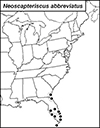|
Alien origin and spread of this SINA species.
|
|
Song:
|
No calling song. Males produce weak, l-5 pulse chirps during courtship.
|
|
Identification:
|
Tibial dactyls slightly divergent, separated at base by space equal to at least half of basal width of a dactyl. Viewed from rear, sharp lower edge of trochantal blade extending less than half distance from trochantal tip to junction with femur. Pronotal pattern complex. Forewings shorter than pronotum; hindwings concealed by forewings. Length 22-29 mm.
|
|
Similar species:
|
N. borellii and N. vicinus have forewings longer than pronotum and hindwings longer than abdomen. Last stage juveniles of these two species have short wings, but hindwings are still longer than forewings.
|
|
Habitat:
|
Sandy soils, usually near the coast; beaches, lawns, fields, and groves.
|
|
Season:
|
All stages occur all year.
|
|
Remarks:
|
This species, like the other two species of Neoscapteriscus, is native to South America and was inadvertently brought into southern ports about l900. Since it cannot fly, its subsequent spread has depended on human transport, probably in manure, sod, and nursery stock. This could account for its spotty distribution and its restriction to suburban and agricultural areas. For unknown reasons almost all records are coastal.
|
|
More information:
|
Family Gryllotalpidae, genus Neoscapteriscus.
|
|
References:
|
Castner & Nation 1986, see additional references on genus page.
|
|
Nomenclature:
|
OSF (Orthoptera Species File Online).
|













